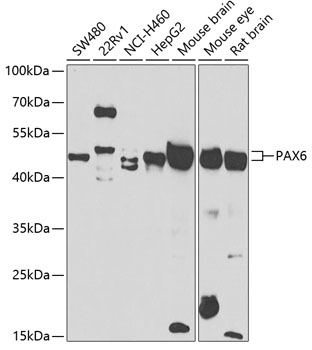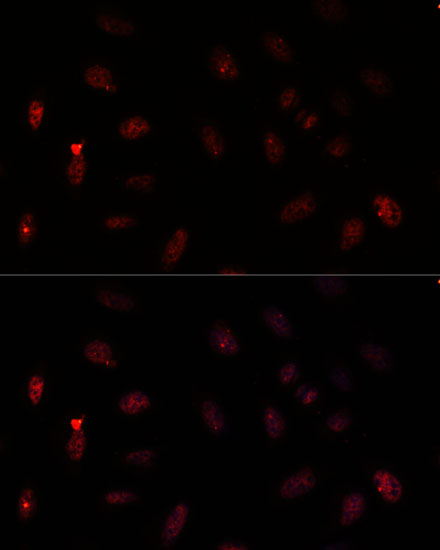Anti-PAX6 Antibody (CAB7334)
- SKU:
- CAB7334
- Product type:
- Antibody
- Reactivity:
- Human
- Reactivity:
- Mouse
- Reactivity:
- Rat
- Host Species:
- Rabbit
- Isotype:
- IgG
- Antibody Type:
- Polyclonal Antibody
- Research Area:
- Developmental Biology
Description
| 抗体名: | Anti-PAX6 Antibody |
| 抗体コード: | CAB7334 |
| 抗体サイズ: | 20uL, 50uL, 100uL |
| 申し込み: | WB IF |
| 反応性: | Human, Mouse, Rat |
| 宿主種: | Rabbit |
| 免疫原: | Recombinant fusion protein containing a sequence corresponding to amino acids 1-300 of human PAX6 (NP_000271.1). |
| 申し込み: | WB IF |
| 推奨希釈: | WB 1:500 - 1:2000 IF 1:50 - 1:200 |
| 反応性: | Human, Mouse, Rat |
| ポジティブサンプル: | SW480, 22Rv1, NCI-H460, HepG2, Mouse brain, Mouse eye, Rat brain |
| 免疫原: | Recombinant fusion protein containing a sequence corresponding to amino acids 1-300 of human PAX6 (NP_000271.1). |
| 精製方法: | Affinity purification |
| ストレージバッファ: | Store at -20'C. Avoid freeze / thaw cycles. Buffer: PBS with 0.02% sodium azide, 50% glycerol, pH7.3. |
| アイソタイプ: | IgG |
| 順序: | MQNS HSGV NQLG GVFV NGRP LPDS TRQK IVEL AHSG ARPC DISR ILQV SNGC VSKI LGRY YETG SIRP RAIG GSKP RVAT PEVV SKIA QYKR ECPS IFAW EIRD RLLS EGVC TNDN IPSV SSIN RVLR NLAS EKQQ MGAD GMYD KLRM LNGQ TGSW GTRP GWYP GTSV PGQP TQDG CQQQ EGGG ENTN SISS NGED SDEA QMRL QLKR KLQR NRTS FTQE QIEA LEKE FERT HYPD VFAR ERLA AKID LPEA RIQV WFSN RRAK WRRE EKLR NQRR QASN TPSH IPIS SSFS TSVY QPIP |
| 遺伝子ID: | 5080 |
| Uniprot: | P26367 |
| セルラーロケーション: | Nucleus |
| 計算された分子量: | 46kDa/48kDa |
| 観察された分子量: | 47kDa |
| 同義語: | AN, AN2, ASGD5, D11S812E, FVH1, MGDA, WAGR, PAX6 |
| バックグラウンド: | This gene encodes a homeobox and paired domain-containing protein that binds DNA and functions as a regulator of transcription. Activity of this protein is key in the development of neural tissues, particularly the eye. This gene is regulated by multiple enhancers located up to hundreds of kilobases distant from this locus. Mutations in this gene or in the enhancer regions can cause ocular disorders such as aniridia and Peter's anomaly. Use of alternate promoters and alternative splicing result in multiple transcript variants encoding different isoforms. |
| UniProt Protein Function: | PAX6: Transcription factor with important functions in the development of the eye, nose, central nervous system and pancreas. Required for the differentiation of pancreatic islet alpha cells. Competes with PAX4 in binding to a common element in the glucagon, insulin and somatostatin promoters. Regulates specification of the ventral neuron subtypes by establishing the correct progenitor domains. Isoform 5a appears to function as a molecular switch that specifies target genes. Defects in PAX6 are the cause of aniridia (AN). A congenital, bilateral, panocular disorder characterized by complete absence of the iris or extreme iris hypoplasia. Aniridia is not just an isolated defect in iris development but it is associated with macular and optic nerve hypoplasia, cataract, corneal changes, nystagmus. Visual acuity is generally low but is unrelated to the degree of iris hypoplasia. Glaucoma is a secondary problem causing additional visual loss over time. Defects in PAX6 are a cause of Peters anomaly (PAN). Peters anomaly consists of a central corneal leukoma, absence of the posterior corneal stroma and Descemet membrane, and a variable degree of iris and lenticular attachments to the central aspect of the posterior cornea. Defects in PAX6 are a cause of foveal hypoplasia (FOVHYP). Foveal hypoplasia can be isolated or associated with presenile cataract. Inheritance is autosomal dominant. Defects in PAX6 are a cause of keratitis hereditary (KERH). An ocular disorder characterized by corneal opacification, recurrent stromal keratitis and vascularization. Defects in PAX6 are a cause of coloboma of iris choroid and retina (COI); also known as uveoretinal coloboma. Ocular colobomas are a set of malformations resulting from abnormal morphogenesis of the optic cup and stalk, and the fusion of the fetal fissure (optic fissure). Severe colobomatous malformations may cause as much as 10% of the childhood blindness. The clinical presentation of ocular coloboma is variable. Some individuals may present with minimal defects in the anterior iris leaf without other ocular defects. More complex malformations create a combination of iris, uveoretinal and/or optic nerve defects without or with microphthalmia or even anophthalmia. Defects in PAX6 are a cause of coloboma of optic nerve (COLON). Defects in PAX6 are a cause of bilateral optic nerve hypoplasia (BONH); also known as bilateral optic nerve aplasia. A congenital anomaly in which the optic disc appears abnormally small. It may be an isolated finding or part of a spectrum of anatomic and functional abnormalities that includes partial or complete agenesis of the septum pellucidum, other midline brain defects, cerebral anomalies, pituitary dysfunction, and structural abnormalities of the pituitary. Defects in PAX6 are a cause of aniridia cerebellar ataxia and mental deficiency (ACAMD); also known as Gillespie syndrome. A rare condition consisting of partial rudimentary iris, cerebellar impairment of the ability to perform coordinated voluntary movements, and mental retardation. Belongs to the paired homeobox family. 3 isoforms of the human protein are produced by alternative splicing. |
| UniProt Protein Details: | Protein type:Transcription factor; Motility/polarity/chemotaxis; DNA-binding Chromosomal Location of Human Ortholog: 11p13 Cellular Component: cytoplasm; nuclear chromatin; nucleoplasm; nucleus Molecular Function:DNA binding; histone acetyltransferase binding; protein binding; protein kinase binding; transcription factor activity; transcription factor binding; ubiquitin-protein ligase activity Biological Process: blood vessel development; central nervous system development; eye development; glucose homeostasis; negative regulation of neurogenesis; organ morphogenesis; positive regulation of transcription from RNA polymerase II promoter; positive regulation of transcription, DNA-dependent; response to wounding; transcription from RNA polymerase II promoter; visual perception Disease: Aniridia; Aniridia, Cerebellar Ataxia, And Mental Retardation; Coloboma Of Optic Nerve; Foveal Hypoplasia 1; Keratitis, Hereditary; Optic Nerve Hypoplasia, Bilateral; Peters Anomaly; Wilms Tumor, Aniridia, Genitourinary Anomalies, And Mental Retardation Syndrome |
| NCBI Summary: | This gene encodes a homeobox and paired domain-containing protein that binds DNA and functions as a regulator of transcription. Activity of this protein is key in the development of neural tissues, particularly the eye. This gene is regulated by multiple enhancers located up to hundreds of kilobases distant from this locus. Mutations in this gene or in the enhancer regions can cause ocular disorders such as aniridia and Peter's anomaly. Use of alternate promoters and alternative splicing result in multiple transcript variants encoding different isoforms. [provided by RefSeq, Jul 2015] |
| UniProt Code: | P26367 |
| NCBI GenInfo Identifier: | 6174889 |
| NCBI Gene ID: | 5080 |
| NCBI Accession: | P26367.2 |
| UniProt Secondary Accession: | P26367,Q6N006, Q99413, |
| UniProt Related Accession: | P26367 |
| Molecular Weight: | – Da |
| NCBI Full Name: | Paired box protein Pax-6 |
| NCBI Synonym Full Names: | paired box 6 |
| NCBI Official Symbol: | PAX6 |
| NCBI Official Synonym Symbols: | AN; AN2; FVH1; MGDA; WAGR; D11S812E |
| NCBI Protein Information: | paired box protein Pax-6 |
| UniProt Protein Name: | Paired box protein Pax-6 |
| UniProt Synonym Protein Names: | Aniridia type II protein; Oculorhombin |
| Protein Family: | Paired box protein |
| UniProt Gene Name: | PAX6 |
| UniProt Entry Name: | PAX6_HUMAN |



